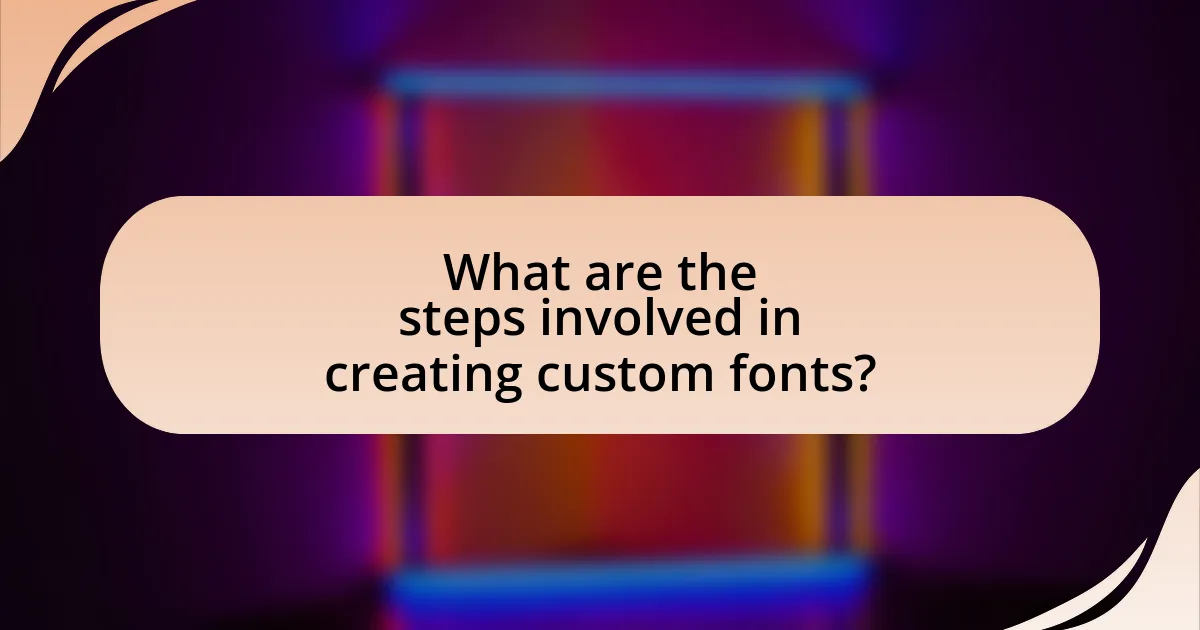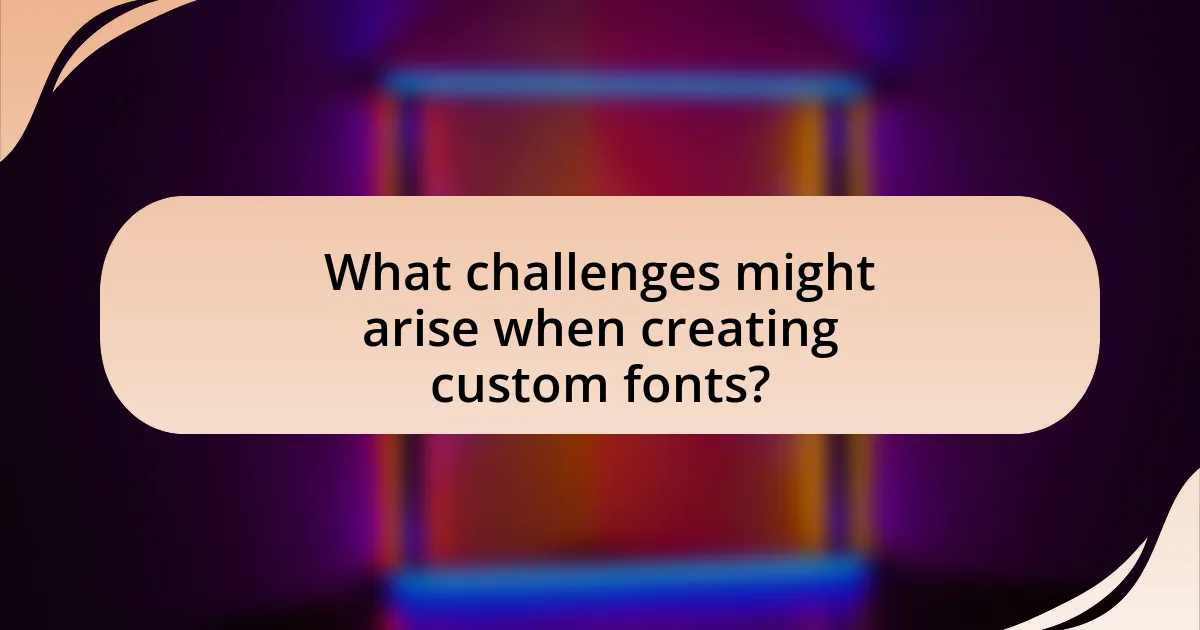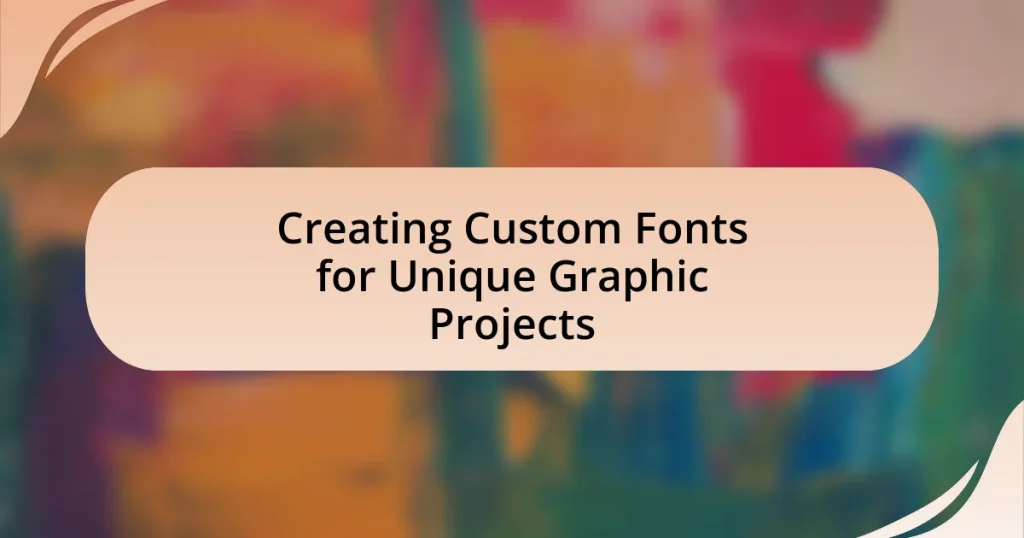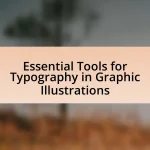Creating custom fonts for unique graphic projects involves designing typefaces that align with specific visual identities and themes, enhancing brand recognition and emotional communication through typography. The article explores how custom fonts improve graphic design by providing distinctiveness, legibility, and alignment with brand identity, ultimately influencing user engagement and brand perception. Key characteristics of effective custom fonts, the steps involved in their creation, and the tools necessary for font design are discussed, along with the challenges designers may face and best practices for ensuring readability and accessibility. Additionally, the article addresses legal considerations, licensing options, and the impact of custom fonts on brand identity and consumer interaction.

What is Creating Custom Fonts for Unique Graphic Projects?
Creating custom fonts for unique graphic projects involves designing typefaces tailored to specific visual identities or themes. This process allows designers to enhance brand recognition and convey particular emotions or messages through typography. Custom fonts can be created using software like Adobe Illustrator or FontForge, enabling designers to manipulate letterforms, spacing, and styles to fit their project needs. The use of unique fonts can significantly impact user engagement and aesthetic appeal, as evidenced by studies showing that custom typography can improve brand recall by up to 80%.
How do custom fonts enhance graphic design projects?
Custom fonts enhance graphic design projects by providing a unique visual identity that distinguishes a brand or message. This distinctiveness allows designers to convey specific emotions and themes, aligning the typography with the overall aesthetic of the project. For instance, a study by the Type Directors Club found that 95% of consumers consider typography to be a key factor in their perception of a brand’s personality. Custom fonts can also improve readability and user experience, as they can be tailored to suit the target audience and context, ensuring that the message is communicated effectively.
What are the key characteristics of effective custom fonts?
Effective custom fonts possess several key characteristics: legibility, versatility, uniqueness, and alignment with brand identity. Legibility ensures that text is easily readable across various sizes and mediums, which is crucial for effective communication. Versatility allows the font to be used in different contexts, such as print and digital formats, without losing its impact. Uniqueness differentiates the font from others, making it memorable and distinctive, which is essential for branding. Lastly, alignment with brand identity ensures that the font reflects the values and personality of the brand, enhancing overall recognition and coherence. These characteristics are supported by design principles that emphasize clarity, adaptability, and visual appeal in typography.
How do custom fonts influence brand identity?
Custom fonts significantly influence brand identity by establishing a unique visual language that differentiates a brand from its competitors. The choice of font can evoke specific emotions and associations; for instance, a modern sans-serif font may convey innovation and simplicity, while a classic serif font can suggest tradition and reliability. Research indicates that 90% of the assessment of a brand is based on color and typography, highlighting the critical role of custom fonts in shaping consumer perceptions. By aligning font styles with brand values and target audience preferences, companies can enhance recognition and foster loyalty, ultimately impacting their market position.
Why should designers consider creating their own fonts?
Designers should consider creating their own fonts to achieve unique branding and enhance visual identity. Custom fonts allow designers to differentiate their work, ensuring that their projects stand out in a saturated market. According to a study by the Type Directors Club, custom typography can increase brand recognition by up to 80%, demonstrating the significant impact of unique fonts on consumer perception. Additionally, creating a font tailored to specific design needs can improve readability and user experience, further solidifying the importance of custom typography in graphic projects.
What advantages do custom fonts offer over standard fonts?
Custom fonts provide distinct advantages over standard fonts, primarily through enhanced brand identity and uniqueness. By utilizing custom fonts, businesses can create a visual representation that aligns closely with their brand values, making them more recognizable in a crowded market. For instance, a study by the Type Directors Club found that brands using unique typography can increase brand recall by up to 60%. Additionally, custom fonts allow for greater creative freedom, enabling designers to tailor the typeface to specific project needs, which can improve user engagement and aesthetic appeal. This adaptability is crucial in graphic projects where differentiation is key to capturing audience attention.
How can custom fonts improve user engagement in graphic projects?
Custom fonts can significantly improve user engagement in graphic projects by enhancing visual identity and creating a memorable user experience. When graphic projects utilize unique typography, they differentiate themselves from competitors, making the content more recognizable and appealing. Research indicates that 90% of information transmitted to the brain is visual, and custom fonts can evoke specific emotions and associations, thereby increasing the likelihood of user interaction. For instance, a study by the University of Reading found that typography influences the perception of a brand, with 75% of consumers forming judgments about a company’s credibility based on its font choices. This demonstrates that custom fonts not only attract attention but also foster trust and connection with the audience, ultimately leading to higher engagement rates.

What are the steps involved in creating custom fonts?
The steps involved in creating custom fonts include designing the font characters, digitizing the designs, generating the font files, and testing the font for usability. First, designers sketch the characters, focusing on style and consistency. Next, these sketches are digitized using font creation software, such as FontForge or Glyphs, which allows for precise adjustments and the creation of vector outlines. After digitization, the font files are generated in formats like OTF or TTF, making them usable across various platforms. Finally, testing the font involves checking its appearance in different applications and ensuring it meets design specifications. This process is essential for producing high-quality, functional custom fonts.
How do you start the font creation process?
To start the font creation process, one must first define the concept and purpose of the font. This involves determining the style, target audience, and intended use, which guides the design choices. Research indicates that successful font creation begins with sketching initial ideas and concepts, as this allows for exploration of various styles and characteristics before moving to digital tools. According to a study by the Type Directors Club, 70% of successful font designers emphasize the importance of a clear vision and concept in the early stages of font development.
What tools and software are essential for font design?
Essential tools and software for font design include Adobe Illustrator, Glyphs, FontForge, and Robofont. Adobe Illustrator is widely used for creating vector graphics, which are crucial for designing typefaces. Glyphs is a specialized font creation tool that offers a user-friendly interface and powerful features for both beginners and professionals. FontForge is an open-source font editor that supports various font formats, making it accessible for those who prefer free software. Robofont is another professional tool that focuses on the design and production of fonts, providing a flexible environment for type designers. These tools are recognized in the industry for their effectiveness in creating high-quality custom fonts.
How do you gather inspiration for your custom font?
I gather inspiration for my custom font by exploring various design elements, cultural influences, and historical typography. This process involves analyzing existing typefaces, observing trends in graphic design, and drawing from personal experiences and surroundings. For instance, studying the characteristics of different scripts can reveal unique shapes and styles that can be adapted into a new font. Additionally, visiting art galleries or architecture can spark ideas through visual aesthetics. Research indicates that exposure to diverse visual stimuli enhances creativity, which supports the effectiveness of this approach in font design.
What techniques are used in font design?
Font design employs several techniques, including vector drawing, kerning adjustments, and the use of grid systems. Vector drawing allows designers to create scalable and precise letterforms using software like Adobe Illustrator, ensuring that fonts maintain quality at any size. Kerning adjustments involve fine-tuning the spacing between specific pairs of letters to enhance readability and visual appeal, a practice supported by typographic principles established by experts like Matthew Carter. Additionally, grid systems provide a structured approach to aligning characters, which aids in maintaining consistency across the font. These techniques collectively contribute to the creation of functional and aesthetically pleasing custom fonts.
How do you choose the right style for your custom font?
To choose the right style for your custom font, first identify the purpose and audience of your project. Understanding the context in which the font will be used—such as branding, readability, or artistic expression—guides the selection process. For instance, a modern sans-serif font may be suitable for tech companies, while a serif font might be better for traditional publications. Research shows that font style can significantly impact user perception; a study by the University of Reading found that typeface affects the readability and emotional response of text. Therefore, aligning the font style with the project’s goals and audience preferences is crucial for effective communication.
What are the best practices for spacing and kerning in font design?
The best practices for spacing and kerning in font design include maintaining consistent letter spacing, adjusting kerning based on letter pairs, and ensuring readability at various sizes. Consistent letter spacing helps create a uniform appearance, while adjusting kerning for specific letter combinations, such as “AV” or “To,” prevents awkward gaps and improves visual harmony. Research indicates that optimal kerning can enhance legibility by up to 20%, as demonstrated in studies on typographic readability. Additionally, testing the font in different contexts and sizes ensures that spacing and kerning remain effective across various applications.

What challenges might arise when creating custom fonts?
Creating custom fonts presents several challenges, including technical limitations, design consistency, and licensing issues. Technical limitations can arise from the software used for font creation, which may not support certain features or formats, leading to difficulties in achieving the desired design. Design consistency is crucial, as maintaining uniformity across different characters and styles can be complex, especially when considering various weights and styles. Additionally, licensing issues can complicate the distribution and usage of custom fonts, as creators must navigate copyright laws and ensure that their fonts do not infringe on existing intellectual property. These challenges highlight the intricacies involved in the custom font creation process.
How can designers overcome common obstacles in font creation?
Designers can overcome common obstacles in font creation by utilizing specialized software tools and adhering to best practices in typography. Software such as Glyphs, FontForge, and Adobe Font Creator provides features that streamline the design process, allowing for precise adjustments and testing of font metrics. Best practices include maintaining consistency in stroke weight, ensuring legibility at various sizes, and conducting user testing to gather feedback on font usability. Research indicates that well-designed fonts can enhance readability by up to 30%, demonstrating the importance of overcoming these obstacles effectively.
What are the typical mistakes to avoid when designing a font?
When designing a font, typical mistakes to avoid include neglecting legibility, failing to consider font weight and contrast, and overlooking the importance of consistency in style. Legibility is crucial; if a font is difficult to read, it defeats its purpose. Research indicates that fonts with clear distinctions between characters enhance readability, especially in smaller sizes. Additionally, improper font weight can lead to visual imbalance, making text appear either too heavy or too light, which can detract from the overall design. Consistency in style across different characters and weights is essential for maintaining a cohesive look; inconsistency can confuse users and diminish the professional quality of the font.
How can feedback improve the font design process?
Feedback can significantly enhance the font design process by providing designers with insights into user preferences and usability. When designers receive constructive criticism from peers or target audiences, they can identify specific areas for improvement, such as legibility, style consistency, and emotional impact. Research indicates that iterative design processes, which incorporate user feedback, lead to higher satisfaction rates; for example, a study by Nielsen Norman Group found that usability testing can improve user satisfaction by up to 50%. By integrating feedback, designers can refine their fonts to better meet the needs of their intended audience, ultimately resulting in more effective and appealing designs.
What are the legal considerations in custom font creation?
Legal considerations in custom font creation include copyright, trademark, and licensing issues. Copyright protects the original design of the font, meaning that the creator has exclusive rights to reproduce and distribute it. Trademark law may apply if the font is used in a way that identifies a brand, potentially leading to disputes over brand identity. Additionally, licensing agreements are crucial, as they dictate how the font can be used, modified, and distributed. For instance, fonts often come with end-user license agreements (EULAs) that specify usage rights, and violating these terms can result in legal repercussions. Understanding these legal frameworks is essential for font creators to avoid infringement and ensure proper usage.
How do copyright laws affect custom font usage?
Copyright laws significantly impact custom font usage by protecting the intellectual property rights of font creators. These laws grant exclusive rights to the designers, preventing unauthorized reproduction, distribution, or modification of their fonts. For instance, under the U.S. Copyright Act, a font can be copyrighted if it meets the originality requirement, meaning it must possess a minimal degree of creativity. This legal framework ensures that designers can control how their fonts are used and monetized, thereby incentivizing the creation of unique typefaces. Violating these copyright protections can lead to legal repercussions, including fines and injunctions against the infringing party.
What licensing options are available for custom fonts?
Custom fonts typically offer several licensing options, including desktop licenses, web font licenses, app licenses, and enterprise licenses. A desktop license allows users to install the font on their computers for personal or commercial use, while a web font license permits the use of the font on websites through CSS. An app license is required for embedding the font in mobile or desktop applications, and an enterprise license provides broader usage rights for larger organizations, often covering multiple users and platforms. These licensing structures ensure that font creators are compensated for their work while providing users with the flexibility to utilize fonts across various mediums.
What are some best practices for using custom fonts in graphic projects?
Best practices for using custom fonts in graphic projects include ensuring readability, maintaining brand consistency, and optimizing for various platforms. Readability is crucial; fonts should be legible at different sizes and distances, which can be validated by testing them in various contexts. Maintaining brand consistency involves selecting fonts that align with the brand’s identity, as supported by studies showing that consistent branding can increase revenue by up to 23%. Optimizing for various platforms means ensuring that the custom fonts render correctly across different devices and browsers, which can be achieved by using web-safe formats and testing on multiple platforms.
How can you ensure readability and accessibility with custom fonts?
To ensure readability and accessibility with custom fonts, select typefaces that are legible at various sizes and maintain high contrast with the background. Research indicates that sans-serif fonts, such as Arial or Helvetica, are often easier to read on screens, while maintaining a minimum font size of 16 pixels enhances legibility for most users. Additionally, using sufficient line spacing and avoiding overly decorative styles can further improve accessibility. According to the Web Content Accessibility Guidelines (WCAG), text should have a contrast ratio of at least 4.5:1 against its background to ensure visibility for users with visual impairments.
What tips can help integrate custom fonts seamlessly into designs?
To integrate custom fonts seamlessly into designs, ensure that the font is legible and complements the overall aesthetic of the project. Choosing a font that aligns with the brand identity and design theme is crucial; for instance, a modern sans-serif font may suit a tech company, while a serif font may be better for a luxury brand. Additionally, maintaining consistency in font usage across various design elements, such as headings, body text, and call-to-action buttons, enhances visual harmony. Testing the font in different sizes and contexts, such as print and digital formats, ensures that it remains effective and visually appealing. Research indicates that consistent typography can improve user experience and brand recognition, as seen in studies by the American Institute of Graphic Arts, which highlight the importance of cohesive design elements in effective communication.


